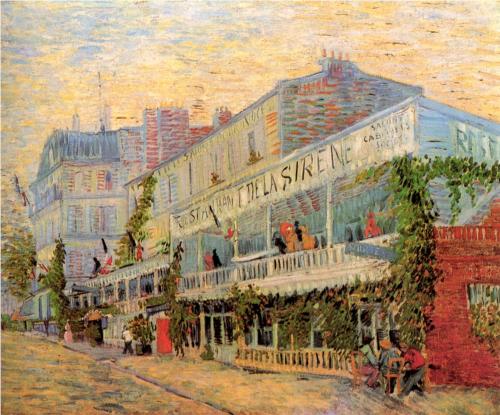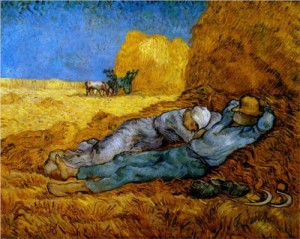Vincent van Gogh

Self Portrait
by Vincent van Gogh, used under ![]()
Even though his art was only produced in a ten-year span, Dutch painter Vincent Van Gogh remains one of the most famous post-impressionist painters that ever lived (Pioch, 2002). He was born in Holland in 1853 and, as a young man, aspired to be a clergyman. Although he decided against the pursuit of religious leadership, Van Gogh would struggle with faith for much of his life (Van Gogh Museum). Bouts of anxiety and depression caused Van Gogh to commit suicide in 1890.
He began to seriously paint only about ten years before his death, taking lessons from his cousin (Van Gogh Museum). He is most remembered for his numerous self-portraits displaying his bold demeanor and for landscape paintings. Certain landscapes, such as “Starry Night”, are among the most recognized pieces of artwork today (Pioch, 2002).

Restaurant de la Sirene at Asnieres
by Vincent van Gogh, used under ![]()
Van Gogh truly gained his fame posthumously; he only sold one painting in his lifetime (Pioch, 2002). Nonetheless, van Gogh left an everlasting imprint on the world of art. Historians credit his style of conveying emotion and feeling in his art as a major influence to expressionism (Van Gogh Museum). We can infer from this that his art was ahead of its time; because his style of painting favored qualities of expressionism, people living during van Gogh’s life were not able to fully appreciate his work. Van Gogh was revolutionary because he was a pioneer in changing art movements. In addition, he was a major influence of the Fauves, some of the first artists to diverge from the pre-existing styles and techniques used in impressionist art (The Metropolitan Museum of Art, Fauvism).
Many of van Gogh’s works are on display at the Van Gogh Museum in Amsterdam, Holland. More information on the museum as well as van Gogh can be found here, the Vincent van Gogh museum.

Rest Work (after millet)
by Vincent van Gogh, used under ![]()
Pioch, N. (2002, 8 19). Gogh, Vincent van. Retrieved 3 26, 2014, from ibiblio.org: www.ibiblio.org/wm/paint/auth/gogh/
The Metropolitan Museum of Art. (n.d.). Fauvism. Retrieved 4 5,2014, from metmuseum.org:http://www.metmuseum.org/toah/hd/fauv/hd_fauv.htm
The Metropolitan Museum of Art. (n.d.). Vincent van Gogh. Retrieved 4 1, 2014, from metmuseum.org: www.metmuseum.org/toah/hd/gogh/hd_gogh.htm
Van Gogh Museum. (n.d.). Retrieved 3 26, 2014, from Van Gogh Museum: www.vangoghmueseum.nl/vgm/index.jsp?page=98&lang=en
Van Gogh, V.(1887) Restaurant de la Sirene at Anieres. [Painting]. Retrieved from www.wikipaintings.org/en/vincent-van-gogh/restaurant-de-la-sirene-at-asnieres-1887-1. Public domain image.
Van Gogh, V. (1890). Rest Work (after millet). [Painting]. Retrieved from www.wikipaintings.org/en/vincent-van-gogh/rest-work-after-millet-1890. Public domain image.
Van Gogh, V. (1887). Self Portrait. [Painting]. Retrieved from www.wikipaintings.org/en/vincent- van-gogh/self-portrait-1887. Public domain image.
